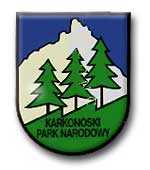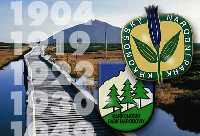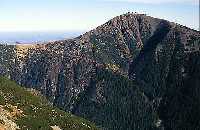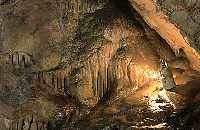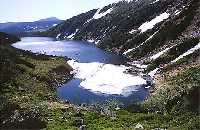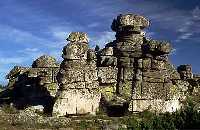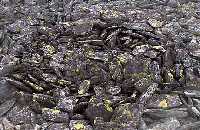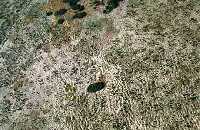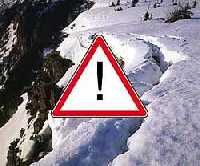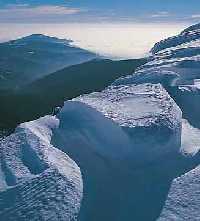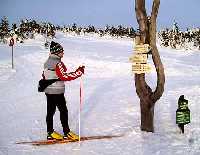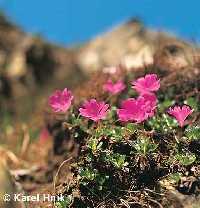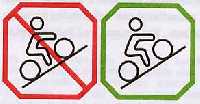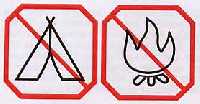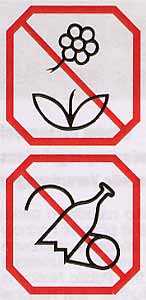
©2008 Mediapool
|
 Nature
 Shown as list
(found: 32 out of 95 records in category: Nature)
Ergis #ID: 2

Climate
The Krkonose Mountains are well known for their unsettled wheather conditions. Its typical oceanic character caters for moderate summers and precipitation-rich winters.
Rainfall:
Ca. 800mm per year, on the ridges ca. 1200-1400mm per year
Snow depth: between 100 and 300 cm
Temperatures: Annual average 0° to +6° C, the coldest month is January (-4,5° to –7,2° C), the hottest month is Juli (8,3° to 14° C)
Ergis #ID: 20

Geological map
1) GRANITE
2) MICA SCHIST AND PHYLITE
3) GNEISS
4) SLATE
5) QUARTZITE
6) CRYSTALLINE CALCITE
Ergis #ID: 34

KRNAP
Krkonošský národní park - KRNAP (Giant Mountain National Park in the Czech Republic) was founded in 1963 as the first national park in the Czech Republic. It covers an area of 370 km2 (570 km2 with a protective zone). It divides into three zones according to the level of preservation - I and II are the most strictly protected zones.
In the area of the park visitors can find many information and tourist centres as well as several thematic exhibitions.
Management of KRNAP is responsible for the preservation of the Giant Mountain nature. This covers mainly regeneration of natural forests, preservation of endangered plant and animal species as well as a range of watch, research, information and cultural activities. The management is not responsible for visitors' security - this is a duty of Rescue Organisation.
KRNAP management
Tourist centres
Ergis #ID: 35

KPN
Karkonoski Park Narodowy - KPN (Giant Mountain National Park in Poland) was founded in 1959 and covers an area of 55 km2.
In the area of the park visitors can find many information and tourist centres as well as several thematic exhibitions.
Management of KPN is responsible for the preservation of the Giant Mountain nature. It is not responsible for visitors' security - this is a duty of Rescue Organisation.
KPN management
Ergis #ID: 36

MaB
In 1992 the Giant Mountains (KRNAP and KPN areas) were incorporated into an international network of biospheric reservations. Biospheric reservations are nominated and enunciated by the world organization UNESCO in the frame of MaB project (Man and Biosphere). These are the most valuable and endangered areas of the world, which are significant for the preservation of the natural wealth and ecological equilibrium on the Earth. The Giant Mountains joined Amazon primeval forests, African Serenghetti savannahs and others in the network. This way UNESCO gains an opportunity to set rules of the preservation of these areas and supports them financially. The biosheric reservation of Krkonoše-Karkonosze (The Giant Mountains) divides into three zones according to the level of preservation: core (contains I and II zones of KRNAP), buffer and transition zones.
Ergis #ID: 37

History of conservation
1904– Earl J. Harrach established the first natural park in Labský pit
1919– the first Czechoslovak notice of the Giant Mountain flora conservation
1922– establishment of the natural park in Malá Sněžná Jáma in Poland
1923– professor Schustler offered a proposal to establish a national park of the Giant Mountains and Jizerské hory
1930– establishment of Kotelská rokle natural park
1949-1959– establisment of 6 natural parks in Poland
1959– establishment of Krkonošský (the Giant Mountains) National Park (KNP) on the Polish side
1963– establishment of Krkonošský (the Giant Mountains) National Park (KRNAP) on the Czech side
1983– initiation of the project of the preservation of genetic resources of the Giant Mountains
1993– selected peat moors of the Giant Mountains are included in the list of Ramsar Convention on Wetlands of International Importance
1993 – initiation of the project of the regeneration of the forests in the Giant Mountains in co-operation with Duth foundation FACE
Ergis #ID: 42

Zones in the Krkonose National Park
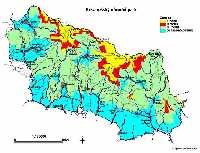 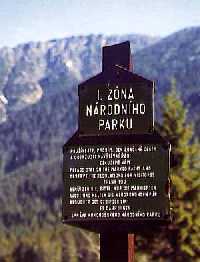
The territory of Krkonose National Park is divided into four categories according to quality and haleness of living environment: 1st zone, 2nd zone, 3rd zone and protective zone.
The 1st zone includes territories with the most significant natural values as follows: the crest regions, iceberg corries, forests and greenfields with high species variety as well as the significant geological formations. Basically continuous, these territories are complemented with certain enclaves such as Cernohorske raseliniste peat bog, Albericke lomy quaries, Rychorska kvetnice and the primeaval forest etc. Besides, one can see in these places the glacial relicts, i.e. species, which are the witnesses to the last ice-age, peat-bog, and the landscape, which is by no means incidentally similar to that of northern tundra. Those seen here are also the results of a long-standing incidence of ice, snow, water and wind on the earth surface – the characteristic granite rocky formations, polygonal soils, corries, terrestrial landslips, endemic species and subspecies, e.g. the hawkweeds, Sudetic Rowan, Bohemian Bellflower etc. Known from the animal species are the snail Cochlodina dubiosa corcontica, and mayfly Rhithrogena corcontica etc.
With more or less broad protective belt, the 2nd zone is previewed to encircle the 1st one. Inherent here of are territories with significant natural values along the upper forest margins and predominantly man’s modified sylvan and meadow-based ecological systems beingsuitable for a limited and parsimonios sylvi-or-agricultural exploitation. This is where you can encounter either the foresters or nature protection field-workers under way of their regulative and curative activity in protecting certain rare species or renewing, e.g. the original composition of vegetation etc. One can see also grazing cattle and an experimental pasturage of sheep.
The 3rd zone comprises the „remainder“ of the KRNAP-protected territory. Why it is in inverted commas is that this territory is concerned 3-times bigger than that of the 1st and 2nd zones altogether. This region faces an intensive both recreational and tourist-related exploitation. In addition, the non-forest soils are loaded here with agricultural production, in particular, the pasturage and haymaking, all in respecting the specific protection scopes of biological variety on the protected territory.
Being not only a proper component of the KRNAP territory, the protective zone in question forms a sort of protective belt to assure the whole park's territory against the spurious impacts. Here we shall find the principal recreational and sport centers such as Harrachov, Spindleruv Mlyn, Pec pod Snezkou and Velka Upa. Here is under way an intensive agricultural activity, namely, the beef raising. Suitable conditions are also available for manufacturing the eco-products.
Ergis #ID: 7

Bluethroat
Peat moors and tundra environment on the Giant Mountain ridges are called "islands of the Arctic in the centre of Europe". Bluethroat is typical evidence that the description fits. In the Giant Mountains there nests a limited population of 25 - 30 couples. To see others we have to visit Scandinavian peat moors. This species belongs among the rarest and most beautiful birds of the Giant Mountains.
Ergis #ID: 19

Granite
The major part of the Polish Giant Mountains and the whole main ridge from Harrachov to the Sněžka mountain consists of granite. In the Palaeozoic era, fervent granite magma insinuated into surrounding crystalline stale and formed a granite massif of up to 5 km thickness. Where the granite magma met carbon rocks the Giant Mountain's ore beds originated. (Obří důl, Svatý Petr, Malá Úpa).
Levelled, slightly curved peaks are typical for granite ridges.
Like other granite massifs the Giant Mountain granite is also disrupted by a system of cracks, which cause its typical decomposition into stone blocks (in the picture we can see stone blocks at Pančava waterfall). On the ridges we can find groups of rocks - so called tory where the erosion abraded sharp blocks into the shape of loafs.
Ergis #ID: 21

Crystalline slate (gneiss, mica schist, phylite,quartzite)
Crystalline slate (gneiss, mica schist, phylite,quartzite) is the most common rock in the Giant Mountains. It appeared in the Palaeozoic era some 500 million years ago. Enormous pressures and extreme temperatures re-melted original layers of sea sediments as well as volcanic lava into new rocks. Layered structure is typical for many kinds of crystalline slate.
Crystalline slate, unlike granite that crumbles into rock blocks, falls into fragments with very sharp edges. This is one of the reasons why crystalline slate ridges are much sharper and steeper. Also rocks present in ridge detritus are of different shapes due to the kind of rocks the particular ridge is formed of.
The inner Czech ridge with adjacent montane crotches and a part of the main ridge from Sněžka mountain to the East is formed of crystalline slate.
Crystalline slate is much more resistant to erosion than granite so the ridges formed of this rock are not so smoothed and slopes are much steeper. (Kozí hřbety, Obří hřeben, Sněžka,...).
Ergis #ID: 22

Calcite
In the mass of crystalline slate there appear insertions and lens of crystalline calcite and dolomites. These are mined at several places of the Giant Mountains (Černý Důl, Horní Lánov, Suchý důl, in the past also Strážné). After polishing they are used for facing (marble), for the production of lime etc. Small caves also appear in the calcite of the Giant Mountains.
<<< Now abandoned quarry in Strážné was once a source of demanded statuary marble.
Ergis #ID: 27

Caves
In the Giant Mountains there are more than twenty small caves, mostly at the East and South rim. They were formed in the past by flowing underground water in calcite layers. Many of them have no natural entry from the surface - they were discovered during calcite mining in quarries. Some have been probably waiting to be discovered until nowadays.
Considering size and stalactical decoration, The Giant Mountain caves can not be compared to Moravian Karst. Although we won't find here large underground rivers, there exist caves with deep underground lakes, which have not been satisfactorily explored yet. Stalactical decoration of the Giant Mountain caves is very poor. Trucovna Cave is an exception (see the picture 2).
In a close neighbourhood of the Giant Mountains we can find richly decorated Bozkovské Caves which are opened for public.
Ergis #ID: 25

Glacial Cirques
During the ice ages of Quarternary Era several glacial tongues appeared in the Giant Mountains.
Masses of ice "flowing" slowly down from the slopes abraded glacial cirques in upper parts and U-shaped valleys in lower parts (Valleys formed by rivers are V-shaped). In local terminology glacial cirques are called "pits" ("jámy").
Slowly flowing glacier pushed before it stones and detritus. It created piles of stones and detritus, which are called front or side moraines. After the glacier disappeared moraines remained. The front moraines sometimes locked the valley and the melted ice created glacial lakes. Glacial lakes can be found mostly on the Polish side of the Giant Mountains. In the Giant Mountains glacial lakes are marked with Polish expression "staw".
Ergis #ID: 26

Karling - Snezka
Sněžka mountain is an exception among all the Giant Mountain peaks. This mountain was ground into the shape of a sharp pyramid by glaciers that clung to it from three sides. A pyramid formed this way is called "karling".
Ergis #ID: 23

Tor
Isolated tower rocks called „tor“ are typical for the peak altitudes of the Giant Mountains as well as the slopes on the Polish side of the main ridge. They were formed during Secondary and Tertiary Eras when erosion caused weathering and loss of softer rocks and uncovered blocks of durable granite which were originally hidden deep under the surface. Uncovered granite rocks were then, as typical for granite, chopped mainly by frost into square blocks. These blocks then eroded into present loaf shapes.
In local terminology these tory are called "stones" - i.e. "Noon Stone" (see the picture 1), "Male Stones", "Girl Stones" (see the picture 2), "Harrach Stones", ...
Ergis #ID: 24

Stony polygons
During ice ages, frost erosion created stone and boulder seas on most of the highest Giant Mountain ridges. Even when standing on the ground, an open-eyed observer can notice almost circular formations of these stones and boulders - polygons. They were not created by any extraterrestrial civilisation but by frost.
Water between the stones repeatedly freezes and melts. Thus its volume changes regularly and water causes stones to be pushed from each other while selects bigger from the smaller ones. In the course of time regular polygonal formations appear. Frost pushes bigger stones away from the centre. On the border of two polygons the stones are pushed against each other and into unnatural upright position.
Some polygons consist only of stones, some have their centres filled by finer detritus or soil, which accommodate grass or small bushes.
Polygons on the slopes slide down due to gravity and soil creep, and stretch into irregular stripes and furrows.
Ergis #ID: 29

Waterfalls
The highest altitudes of the Giant Mountains serve as spring areas of several creeks and rivers. On their way to the valley they must overcome large superelevations and that is where waterfalls appear. The largest waterfalls can be found on the steep slopes of huge glacial valleys – Labský důl pit, Úpská jáma hole etc. The highest one (149 m) is a waterfall of the Pančava river on the edge of Labský důl pit.. The small Pančava river springs at Pačava peat moor (near the spring of Elbe river), falls down on the cascade of granite boulders to the valley bottom and finally join the river Elbe. Near the waterfall there is a tourist route with two view spots on it. In the surroundings of waterfalls we can find a large number of rare plant and animal species bound to the humid environment.
Ergis #ID: 28

Giant Pots
Evorsion is a kind of water erosion, which abrades rocky river-bed with wafted cobble stones and sand like with emery paper. Where the river-bad shape forms vortexes, water abrades circular wells called "giant pots". It is a common formation of the Giant Mountain streams and rivers.
During several millions of years of abrasion the giant pots reached extraordinary depths. Very large and nicely developed ones can be found in the Jizera river near Vilémov. Beautiful pots abraded in granite can be also seen in the Mumlava river near Harrachov.
Ergis #ID: 18

Alpine accentor
Another Giant Mountain curiosity can be watched only on the highest peaks, preferably in the detritus of the Sněžka mountain. The Giant Mountains are the northest area of its worldwide occurrence. Though the population of alpine accentors is very small and does not exceed 15 - 20 couples, it has already remained on this level for many years.
Ergis #ID: 55

Avalanche International Danger Scale
Low 1: Natural avalanches very unlikely. Human triggered avalanches unlikely. Travel is generally safe. Normal caution advised.
Moderate 2: Natural avalanches unlikely. Human triggered avalanches possible. Use caution in steeper terrain on certain aspects.
Considerable 3: Natural avalanches possible. Human triggered avalanches probable. Be increasingly cautious in steeper terrain.
High 4: Natural and human triggered avalanches likely. Travel in avalanche terrain is not recommended.
Extreme 5: Widespread natural or human triggered avalanches certain. Travel in avalanche terrain should be avoided and confined to low angle terrain, well away from avalanche path runouts.
Ergis #ID: 15

Black grouse
Forest gallinacean birds of the Giant Mountains are represented by three species: capercaillie, hazel grouse and grouse. While the first two are only one step from their extinction (in connection with dying of forest and excessive disturbance), grouse likes the vast bleak areas and its population grows. It belongs among endangered species of the Czech Republic, but in the Giant Mountains there are now about 150 males of this bird.
Ergis #ID: 10

Black stork
Everybody knows white stork even from the childhood, but the black relative of his is not so well known. Though it is of almost the same height, but it nests in forests. It hunts skilfully along the hidden montane creeks and lets us see him only when hawking high above in the sky. So look carefully: the belly is white but the neck and wings are all black. And it is more frequent in the Giant Mountains than white stork.
Ergis #ID: 8

Chaffiach
The most frequent bird nesting in the Giant Mountains: each fifth bird within the mountain range and even every third one in the local forests in this finch. We can watch it in all kind of environments from lowlands to the upper forest limit, rarely in dwarf pine growths and never on the highest peaks of no bushy vegetation.
Ergis #ID: 13

Corncrake
If any Giant Mountain bird merits an attribute "invisible", then corncrake is without competition. Though the voice sounds from the montane meadows into long distance, it is absolutely impossible to see the owner. Even the voice sounds as if it belongs to an old cracked branch than to a bird: repeating crex-crex-crex-crex-crex (its voice, put on the paper as "krex-krex" became also basis for its Latin name.) And besides, it most frequently sounds from the dark.
Ergis #ID: 12

Crested tit
Very numerous genus of tits contains also six Giant Mountain species: great tit, marsh tit, blue tit and in the lower areas while coal tit, crested tit and willow tit in the upper ones. . Crested tit with a topknot on its head is a typical species of spruce forests, which sensitively reacts to the forest damage. In is quite numerous in the healthy or slightly damaged forests, while it disappears completely from the hardly damaged and dying ones. The reason lies mainly in the lack of suitable food as well as shelters protecting them from severe weather and enemies. But the situation is the same for other bird species such as goldcrests- our smallest birds.
Ergis #ID: 9

Dipper
A bird species which way of life is bound entirely to running water. It nests near the water, catches food under water and can move very skilfully. Just stand for a while at a frozen river in winter: dipper jumps through one hole into the freezing stream and after a moment it jumps out through another, which can be several metres distant from the first one. How perfectly protective feathers
Ergis #ID: 33

Nature conservation in the Krkonose Mts.
Many visitors don’t perceive that the nature in the Giant Mountains is in a state of serious endangerment. Paradoxically, while prestigious international institutions (Dutch foundation FACE, European Union, UNECSO, The World Bank) help to rescue the valuable nature of the Giant Mountains, we ourselves continually destroy it. The worst menaces of today are not only pollutants but also unregulated invasion of tourism.
You can also contribute to this effort to preserve the nature of the Giant Mountains for future generations by following the visitor regulations of the parks, signs and information boards.
MaB, KRNAP, KPN
History of conservation
Visitor regulations
Ergis #ID: 16

Redpoll
Another species that nested originally only in the dwarf pine growths above the upper forest limit, but recently has descended to lower altitudes including the Giant Mountain base areas. Nevertheless the largest number of this bird can still be found in the scrub growths. It is one of the birds, which can not escape our attention when on a trip along the mountain ridges. We can recognize it easily by its typical cricket-like voice.
Ergis #ID: 14

Ring ouzel
A well known black bird with a white crescent on the chest. Is it nonsense? No, this is just how ring ouzel looks. Another typical representative of montane birds is quite frequent in the Giant Mountains. One of almost 300 nesting couples can be found easily on the montane meadows and forest rims. But only up in the mountains,as it does not come under the altitude of 800 metres above sea level.
Ergis #ID: 11

Teagmalms Owl
Small, inconspicuous owl. It can't be seen but can be heard. If we hear in montane spruce forest a repeated puh-puh-puh-puh-puh-puh resembling distant steam machine, it is Slovakia, as there are no steam machines in the Giant Mountains any more. And there is quite a chance to hear this voice as approx. 100 couples of this bird nest here.
Ergis #ID: 46

The rules of visits to The Krkonoše National Park
ARTICLE 1
Introductory regulations
1) The purpose of this Public Notice is securing the functions of the Krkonoše National Park (further just National Park) given by its mission to protect the natural values of the area for pertaining its stabile ecosystems, and, in addition, for scientific, educational and enlightening use. Especially it takes care of directing the regime of the tourist and recreational activities in the National Park.
2) The Rules of Visits is a generally obligatory legal regulation. Its effect includes all the physical and legal persons present in the area of the Park or carrying there out their activities. The consent with a different regime of behaviour is granted by the Administration of the National Park (further just Administration).
ARTICLE 2
Prohibition and limits to some activities
1) In all the area of the National Park it is forbidden
a) to enter the areas with newly-planted vegetation done to support the wood restoration
b) to enter caves and other underground spaces
c) to scare and catch wild animals
d) to pick wild plants or their parts except fruits of forest plants
e) to throw away rubbish, to litter or damage springs and waterways
f) to manipulate or damage the equipment for tourism and recreation located in terrain like tourist marking, information boards, rest places, view-points and other generally useful facilities
g) to let dogs run free
h) to behave in a way that could cause damage to the environment and which is in contradiction to the mission of the National Park, esp. to disturb the quiet by excessive noise etc.
i) to organize group sporting, tourist and other actions
j) to install removable ski-lifts and mark winter cross-country and down-hill skiing tracks and both summer and winter tourist tracks
k) to camp and to make fires
l) to ride horses and organize dog-team rides
m) to practise water sports except the Jizera river and upper reach of the Labe river (reach Labská Dam–Kukačka)
2) The Administration can, in designated areas or certain times give consent to activities listed under i), j), k), l) and m) of paragraph 1). The actions carried out on regular attested XC or DH ski tracks are not considered activities listed under the letter i). These, however, must be announced at the Administration beforehand.
3)In winter the access to hunters’ facilities for feeding the animals and to winter-support areas is forbidden with the exception of marked tourist paths.
4) In the areas of zone I and zone II of the National Park besides the activities listed in paragraph 1) it is also forbidden to pick the fruits of forest plants and to enter areas outside marked tourist paths, or, in winter, outside the pole-marked paths, including ski-alpinism.
5) In case of insufficient snow cover it is obligatory for the visitors to respect the closed-down parts of pole marking having been closed by the Administration for the purpose of nature protection.
6) The conditions of car entry, stay and driving in the area of the National Park including the fees are determined by the Public Notice No 2/1995 of the Administration and the persons within the boundaries of the Park shall abide by them.
ARTICLE 3
Mountain Cycling
It is forbidden to practise cycling in the Park outside roads, local communications and paths designated for that purpose with the consent of the Administration. The paths for mountain cycling and the conditions of their operation are determined in a special decision of the Administration
ARTICLE 4
Mountaineering and flying
In the area of the National Park it is forbidden to practise mountaineering with the exception of following parts:
– Hnědé skály rocks (k. ú. Strážné, p. p. č. 1958/1)
– Hranostají skála rock (k. ú. Strážné p. p. č. 1892)
– Emin kámen stone (k. ú. Labská, p. p. č. 103/16, 17)
– Lubošské skály rocks (k. ú. Harrachov, p. p. č. 1033/36).
All the nature components of the mountaineering terrains will receive maximum protection
2) Paragliding and hang-gliding are forbidden in all the area of the Park with the exception of the operation parts of the delimited flight corridors determinated by independent decision of The Administration. Operating areas are marked by signboards with obligatory signs.
ARTICLE 4a
Water sports
1) It is possible to do water sports – run down the Jizera river and upper reach of the Labe river (reach Labská Dam–Kukačka) on the crafts without an engine.
2) To aboard and get off the craft is possible only on determinated places. Those places and their entrances are marked with signboards.
3) To do water sports on the Labe river is possible only under permission of The Administration. Floating time of the day is from 8AM till 6PM. Terrain Service Center of the Administration in Špindlerův Mlýn emits the permission with other floating conditions.
ARTICLE 5
Information, educational and enlightening activities
The protection of nature, the educational and enlightening use of the National Park are directed and organized by the Administration. For these purposes there are information centres established in Pec pod Sněžkou, Špindlerův Mlýn, Vrchlabí, Harrachov and Rokytnice nad Jizerou. While organizing this activity the Administration cooperate with the municipal and local authorities. The above listed centres provide information about closed-down ways (art. 2, par. 5), the cyclotouring tracks (art. 3) etc.
ARTICLE 6
The guards of nature, fines
1)The inspection over keeping the rules within this Public Notice and other generally obligatory legal regulations is carried out by the guards of nature of the Administration. After showing their service-card, the guards are entitled to:
a) determine the identity of persons infringing the regulations in the sphere of nature protection
b) impose and collect the block fines up to 1000 Kč
c) stop the infringing activity if its continuation should endanger the nature immediately
d) detain a suspicious person who is found to be breaching legal regulations regarding nature and country for identification and hand that person over to the Czech Republic Police Authority; caught persons are obliged to obey
e) ask for help or co-operation of the Czech Republic Police Authority possibly municipal police if meeting their obligations cannot be ensured through their own powers and means
2) Trespassing the regulations within the Public Notice can be fined by the Administration in the case of physical person up to 10 000 Kč; the legal as well as physical persons undertaking business activities can be fined up to 500 000 Kč
ARTICLE 7
Transient, general and final regulations
1) The entrance prohibition under art. 2, par. 4 does not concern the owners and tenants of the land
2) For the purpose of this Public Notice winter period is meant within December 15 and March 15
3) The effect of this Public Notice as amended starts on April 15, 1993
Ergis #ID: 17

Water pipit
There are not many bird species, which welcome the Giant Mountain forests dying off, but meadow pipit belongs among them. They nested originally only on the meadows above the upper forest limit, but today they colonise also the vast bleak areas in the centre of the forests and their population grows continuously.
|
Our tip
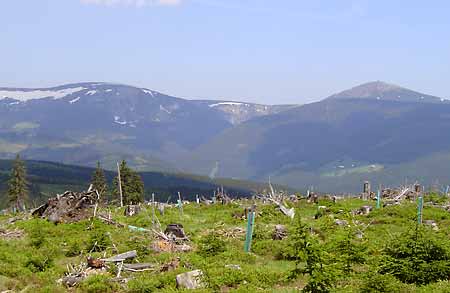 Janské Lázně
Janské Lázně
Our tip
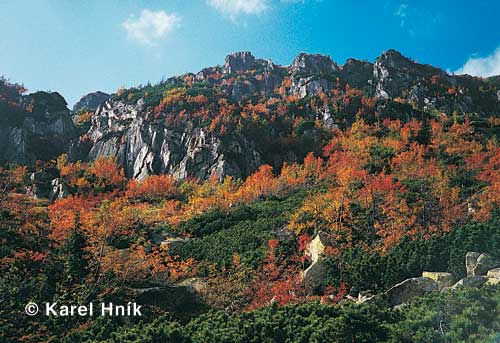
Our tip

Our tip
 Pec pod Sněžkou
Pec pod Sněžkou
Our tip
 Pec pod Sněžkou
Pec pod Sněžkou
Our tip
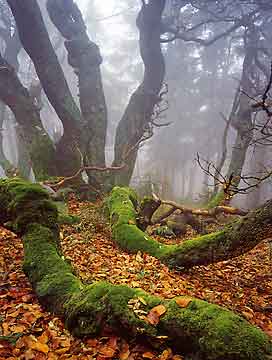 Horní Maršov
Horní Maršov
|






